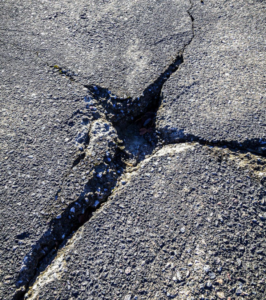
When investigating the cause of a falling accident, forensic engineers employ a multi-pronged approach to determine the cause, who is liable, and what it would take to bring the area in question into safety compliance. Through physical evidence evaluation, environmental assessments, and technical reconstructions of the incident, they point out root causes of the incident and contributing factors. Key considerations in such investigations include:
Physical Site Evaluation
A detailed inspection of the accident site usually comes first, and the questions an engineer may ask themself include:
- Surface conditions: Were cracks and debris present that could cause trips or slips? How about potholes or unnatural dips on the sidewalk or parking lot surface?
- Drainage systems: Is the area of the fall prone to standing water, ice patches, or improper slope gradients?
- Lighting adequacy: If the incident occurred at night, what were the illumination levels? Photometric tools would likely be used to determine if lighting was less than 10 lux in walkable areas. Such poor lighting can obscure hazards.
- Appropriate warnings: Absence of wet floor signs, obscured hazard markings, or non-compliant ADA accessibility features can make building owners liable. Signage is key.
Environmental and Human Factors
Further questions take into consideration factors that may vary from moment to moment, day to day.
- Weather data: How much rain or wind was present at the time of the accident? What was the temperature? Was it low enough to turn rain or snow into ice?
- The fall victim: What type of shoes and soles did the victim wear that day? Do they walk with a non-typical gait or are they disabled in some way? Did they have a cane, walker, or a healing injury at the time?
- Surveillance footage: Security camera recordings are invaluable for analyzing the accident and surrounding conditions.
- Witnesses: Can those present that day account for lighting conditions, surface defects, or neglected maintenance.
Compliance and Liability Assessment
Liability can often be determined by comparing applicable codes, standards, and paperwork with the compliance of the area in question.
- Building codes: Forensic engineers will measure guardrails, ramps, handrails, and the like and compare them applicable building codes.
- Industry standards: Are ASTM guidelines for slip resistance met?
- Maintenance records: Will the building’s maintenance records offer evidence of delayed repairs or upkeep of tripping zones such as faulty curbs or cracked asphalt and concrete?
Technical Analysis Methods
This is where forensic technical skills are extra valuable.
- Finite Element Modeling: Simulating weight distribution on damaged surfaces can identify where materials/surfaces failed.
- Material testing: Spectrographic analysis detects premature degrading or ineffective material mixes of surfaces.
- Lighting simulations: Using algorithms for the position of the sun and luminaire specs, the engineer can build 3D recreations of incident-time illumination.
Need help with your fall investigation? Give us a call!
201.722.1233


